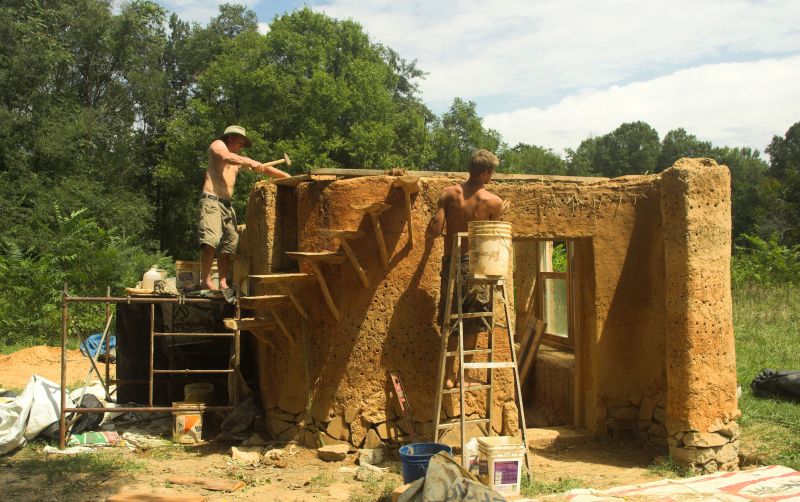Table Of Content

A cob cottage is a great housing choice for someone living on an organic farm. You can invest in solar power to sort out your other energy needs. Remember to take a course on how to build a cob house before you start building. Cob walls must be arranged evenly for adequate weight distribution.
# Energy efficient

So you need to dig a trench to encircle the structure to lead water away. Importantly, the cost of land varies significantly by location, from a few to hundreds of thousands of dollars. Another cost-saving option is to look into building your cob house in an intentional community with like-minded residents. Of course, the most significant savings come from building a cob house yourself. If you hire out, the overall cost can triple due to the labor-intensive nature of building a cob house. Currently, there has been no building code for cob in North America.
FREE Tiny House Plans!
When one talks of acoustic insulation, cob houses are right up there among the best. Walls made from earthen material has excellent sound-absorbing properties which keep the outside noises subdued to a great extent and vice-versa. Since soil is used as the base material for the building it is almost completely fireproof and termite-proof. This makes cob house one of the safest DIY homes that one can go for.
The Cob Cottage Company
Completing the walls could take months depending on the size of the structure due to the drying required. It first became popular as a building technique for one-story structures as it did not require costly or heavy timber. However, for multi-story cob structures, timber supports are usually needed.
Victor couple turns cob house project into natural building business - NBC Montana
Victor couple turns cob house project into natural building business.
Posted: Sat, 05 Aug 2023 07:00:00 GMT [source]
The important part of cob is getting the mix right, you want roughly between 2 parts clay, 1 part sand, sprinkling of straw and a little water. To mix these together the favorite method is with your bare feet! I love the feeling of the cob squishing between your toes, so much fun! You want the ingredients to be very well mixed, moist, but not wet and the straw well worked in. Creating a cob house often creates a very healthy home for air quality. The one area you’ll need to spend some attention on is moisture levels.
A low heating requirement means saving on your energy bills. Thanks to its construction technique, cob is one of the materials that are highly resistant to seismic activities. As such, the only way to mitigate the impact of such events is by building with materials that are highly resistant to seismic activities. The oldest known cob house has existed for more than 10,000 years.

You want to dig down to below your frost line which can be 2-3 feet in some areas. From there build your base with quality materials and tamp down with a powered tamper as you build your way up. As people realize the need, we could get building codes enacted for cob and not have to worry about this issue anymore. There are cases in which you don’t need to get a permit for a building at all, and can just build what you want to.
What Counties in Tennessee Allow Tiny Houses – Rules and Regulations You Need To Consider
But of course, the overall cost depends on what goes into your house, from windows to roofing. To keep your costs low, seek out recycled and salvaged materials. While relatively easy to build, it can be quite time-consuming. It takes a whole lot of mixing to make enough cob to build an entire house, even a tiny one. Another aspect of durability is the ability to withstand the elements and safety threats. Because of its porous nature, cob houses can withstand long periods of rain without weakening or weathering.
Best Reclaimed Wood Construction Companies in Indiana
Building a cob house is an excellent way to connect with nature, reduce your carbon footprint, and create a unique home. Add a layer of insulation between the rafters and cover it with waterproof material before adding the turf. Make sure to sieve out any big pieces from sand and straw before mixing with clay. Ensure you add sufficient straw to bind the mixture together. The straw should be enough so that each handful of cob has straw strands running through it.
Builders will mold the cob into thick walls using their hands, working their way up from the foundation to the roof. Once the walls are dry, they can be plastered over with clay or lime plaster for added durability. Stones give the house a natural and homey charm to a cob house. However, the stemwall may be one of the most expensive parts of building a cob home due to the cost of some stones. Read my more in-depth article about how to build a stone foundation.
Couple's business teaches how to build cob houses and live debt-free - Business Insider
Couple's business teaches how to build cob houses and live debt-free.
Posted: Tue, 29 Aug 2023 07:00:00 GMT [source]
An improperly mixed cob reduces the durability of cob houses. Draw a house plan to suit your preferences and the land you are building on. It is best not to build cob houses in flood plains because cob is highly susceptible to water damage from extended exposure. The good thing about building cob houses is how they follow bumpy terrains.
He has written on homesteading, natural building, and appropriate technologies for Mother Earth News magazine since 2013. Katy Chandler is a former math teacher, a master gardener, and a permaculture designer. Their urban homestead and learning space was a Mother Earth News Homestead of the Year and has welcomed thousands of people over the years for classes, tours, and events.
Your cob home has more protection against fire disasters than modern buildings. The materials used for cob, clay, and sand are naturally fire-resistant. Material Cultures used air-dried hempcrete (a bio-composite of hemp and a lime-based binder) for this roughly 970-square-foot residential build. Locally sourced timber and wood-fiber insulation are also among the materials used. A rainscreen cladding of larch, also locally sourced, is situated beneath the eaves of the shingled roof.
Consequently, the carbon footprint of a cob house is exceptionally low. Since the material used for cob house construction is locally sourced, it is a dirt-cheap method of building a dwelling which will last for years. All you need is a piece of land to erect the structure, and it will cost you almost one-tenth the cost of building a conventional home. As an added advantage there is zero carbon footprint which goes very well for eco-friendly living.
Also, you might hire a natural builder to help you with construction. To build a cob home, you need some necessary construction skills. However, you can take cob building courses to learn how to build comb homes. It also creates a sense of unity within the community, promoting social sustainability.
The thatch, of course, is the bundled reeds and rushes that are sculpted to conform to and protect the roof. On the Hardy cottage, the thatch is cut above the second story windows, just as the cob walls themselves would have been cut and shaped. Cob and thatch homes are most commonly seen in the West Country of rural South West England. It’s hand-sculpted using local, sustainable natural materials, and located on a lovely acreage with sheep, gardens, and orchards.

No comments:
Post a Comment